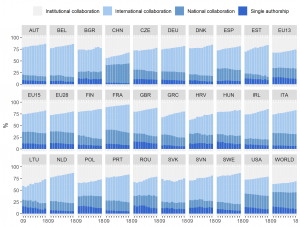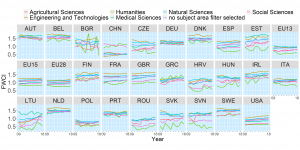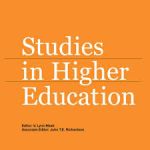Marek Kwiek’s analysis of international research collaboration in Europe in the last decade is published in „Studies in Higher Education”:
„What large-scale publication and citation data tell us about international research collaboration in Europe: changing national patterns in global contexts„.
Kwiek, M. (2020). „What large-scale publication and citation data tell us about international research collaboration in Europe: changing national patterns in global contexts„. Studies in Higher Education. Online first: 10 Apr 2020, https://doi.org/10.1080/03075079.2020.1749254.
This study analyzes the unprecedented growth of international research collaboration (IRC) in Europe during the period 2009–2018 in terms of co-authorship and citation distribution of globally indexed publications. The results reveal the dynamics of this change, as growing IRC moves European science systems away from institutional collaboration, with stable and strong national collaboration. Domestic output has remained flat. The growth in publications in major European systems is almost entirely attributable to internationally co-authored papers. A comparison of trends within the four complementary collaboration modes clearly reveals that the growth of European science is driven solely by internationally co-authored papers. With the emergence of global network science, which diminishes the role of national policies in IRC and foregrounds the role of scientists, the individual scientist’s willingness to collaborate internationally is central to advancing IRC in Europe. Scientists collaborate internationally when it enhances their academic prestige, scientific recognition, and access to research funding, as indicated by the credibility cycle, prestige maximization, and global science models. The study encompassed 5.5 million Scopus-indexed articles, including 2.2 million involving international collaboration.
Selected visualization of a decade (2009-2018) of changes:
Figure 3. Increasing international collaboration at the expense of institutional collaboration, with stable national collaboration (for all fields of research and development combined): Europe as EU-28, EU-15, and EU-13 plus major EU-28 and comparator countries (articles only) 2009–2018 (%).
Figure 4. Total, domestic, and international collaborative publications for France, Germany, and the United Kingdom (2009–2018). All increase in total output is international collaboration; national collaboration remains flat in number, declining in percentage terms.

Figure 8. Field-weighted citation impact (FWCI) of internationally co-authored publications: articles only, self-citations included, by country and field of research and development, 2009–2018.

References
Abbott, A., Butler, D., Gibney, E., Schiermeier, Q., & Van Noorden, R. (2016). Boon or burden: What has the EU ever done for science? Nature, 534, 307–309.
Abramo, G., D’Angelo, C. A., & Di Costa, F. (2019a). The collaboration behavior of top scientists. Scientometrics, 118(1), 215–232.Abramo, G., D’Angelo, C.A., Di Costa, F. (2019b). A gender analysis of top scientists’ collaboration behavior: evidence from Italy. Scientometrics, 120, 405–418.
Abramo, G., D’Angelo, C.A., Murgia, G. (2013) Gender differences in research collaboration. Journal of Informetrics.7: 811-822.
Adams, J. (2013). The fourth age of research. Nature, 497(30 May 2013), 557–560.
Aksnes, D.W., Piro, F.N., & Rørstad, K. (2019). Gender gaps in international research collaboration: A bibliometric approach. Scientometrics, 120, 747–774.
Belli, S., & Baltà, J. (2019). Stocktaking scientific publication on bi-regional collaboration between Europe 28 and Latin America and the Caribbean. Scientometrics, 121(3), 1447-1480.
Cummings, W. K., & Finkelstein, M. J. (2012). Scholars in the Changing American Academy. New Contexts, New Rules and New Roles. Dordrecht: Springer.
Defazio, D., Lockett, A., & Wright, M. (2009). Funding incentives, collaborative dynamics and scientific productivity: Evidence from the EU framework program. Research Policy, 38(2), 293-305.
de Wit, H., & Hunter, F. (2017). Europe: The future of internationalization of higher education in Europe. In G. Mihut, P. G. Altbach, & H. de Wit (Eds.), Understanding higher education internationalization. Insights from key global publications (pp. 25–28). Dordrecht: Sense.
Dobbins, M., & Kwiek, M. (2017). Europeanisation and globalisation in higher education in Central and Eastern Europe: 25 years of changes revisited (1990-2015): Introduction to a special issue. European Educational Research Journal, 16(5), 519-528.
European Commission (2007). The European Research Area: New perspectives. Brussels: The European Commission.
European Commission (2009). Drivers of international collaboration in research. Brussels: The European Commission.
European Commission (2015). Study on network analysis of the 7th framework programme participation. Prepared by Science-Metrix, Fraunhofer ISI and Oxford Research. Brussels: European Commission.
Finkelstein, M., & Sethi, W. (2014). Patterns of faculty internationalization: a predictive model. In F. Huang, M. Finkelstein, & M. Rostan (Eds.), The Internationalization of the Academy. Changes, Realities and Prospects. Dordrecht: Springer. 237-258.
Finkelstein, M. J., Walker, E., & Chen, R. (2013). The American faculty in an age of globalization: Predictors of internationalization of research content and professional networks. Higher Education, 66(3), 325–340.
Fox, M. F, Realff, M. L., Rueda, D. R., & Morn, J. (2017). International research collaboration among women engineers: Frequency and perceived barriers, by regions. Journal of Technology Transfer. 42(6): 1292–1306.
Glänzel, W. (2001). National characteristics in international scientific co-authorship relations. Scientometrics. 51(1), 69–115.
Glänzel, W., & Schubert, A. (2001). Double effort—double impact? A critical view at international co-authorship in chemistry. Scientometrics, 50(2), 199–214.
Godin, B. (2007). Science, accounting and statistics: The input-output framework. Research Policy, 36(9), 498–511.
Hennemann, S., & Liefner, I. (2015). Global science collaboration. In D. Archibugi & A. Filippetti (Eds.), The handbook of global science, technology, and innovation. Somerset, NJ: Wiley.
Hoekman, J., Frenken, K., & Tijssen, R. J. (2010). Research collaboration at a distance: Changing spatial patterns of scientific collaboration within Europe. Research Policy, 41(4), 520–531.
Jeong, S., Choi, J. Y., & Kim, J. Y. (2014). On the drivers of international collaboration: The impact of informal communication, motivation, and research resources. Science and Public Policy, 41(4), 520–531.
Kamalski, J., & Plume, A. (2013). Comparative benchmarking of european and us research collaboration and researchers mobility: A report prepared in collaboration between Science Europe and Elsevier’s SciVal Analytics. Science Europe, Elsevier.
Kato, M., & Ando, A. (2017). National ties of international scientific collaboration and researcher mobility found in nature and science. Scientometrics, 110(2), 673–694.
King, R. (2011). Power and networks in worldwide knowledge coordination: The case of global science. Higher Education Policy, 24(3), 359–376.
König, T. (2017). The European Research Council. Cambridge: Polity.
Kwiek, M. (2015). The internationalization of research in Europe. A quantitative study of 11 national systems from a micro-level perspective. Journal of Studies in International Education, 19(2), 341-359.
Kwiek, M. (2016). The European research elite: A cross-national study of highly productive academics across 11 European systems. Higher Education, 71(3), 379-397.
Kwiek, M. (2018a). International research collaboration and international research orientation: Comparative findings about European academics. Journal of Studies in International Education. 22(2): 136-160.
Kwiek, M. (2018b). Academic top earners. Research productivity, prestige generation and salary patterns in European universities. Science and Public Policy. 45(1). 1–13.
Kwiek, M. (2018c). High Research Productivity in Vertically Undifferentiated Higher Education Systems: Who Are the Top Performers?. Scientometrics. 115(1). 415–462.
Kwiek, M. (2019a). Changing European Academics. A Comparative Study of Social Stratification, Work Patterns and Research Productivity. London and New York: Routledge.
Kwiek, M. (2019b). Social Stratification in Higher Education: What It Means at the Micro-Level of the Individual Academic Scientist. Higher Education Quarterly. Vol. 73. Issue 4. 419-444.
Kwiek, M., Roszka, W. (2020). Gender Disparities in International Research Collaboration: A Large-scale Bibliometric Study of 25,000 University Professors. Journal of Economic Surveys (submitted). Available from: https://arxiv.org/abs/2003.00537.
Kyvik, S., & Aksnes, D. W. (2015). Explaining the increase in publication productivity among academic staff: A generational perspective. Studies in Higher Education, 40, 1438-1453.
Lancho-Barrantes, B. S, Guerrero Bote, V.P., Rodrigues, Z. C., & de Moya Anegon, F. (2012). Citation flows in the zones of influence of scientific collaborations. Journal of the American Society for Information Science and Technology. 63(3), 481–489.
Larivière, V., Vignola-Gagné, E., Villeneuve, C., Gelinas, P., & Gingras, Y. (2011). Sex differences in research funding, productivity and impact: An analysis of Quebec university professors. Scientometrics 87(3): 483-498.
Lasthiotakis, H., Sigurdson, K., & Sá, C. M. (2013). Pursuing scientific excellence globally: Internationalizing research as a policy target. Journal of Higher Education Policy and Management, 35(6), 612–625.
Luukkonen, T., Persson, O., & Sivertsen, G. (1992). Understanding patterns of international scientific collaboration. Science, Technology, & Human Values, 17(1), 101–126
Mattsson, P., Laget, P., Nilsson, A. & Sundberg, C.-J. (2018). Intra-EU vs. extra-EU scientific co-publication patterns in EU. Scientometrics 75, 555–574.
Mayer, S.J., Rathmann, J.M. (2018). How does research productivity relate to gender? Analyzing gender differences for multiple publication dimensions. Scientometrics, 117, 1663-1693.
Melguizo, T., & Strober, M. H. (2007). Faculty salaries and the maximization of prestige. Research in Higher Education, 48(6), 633–668.
Moya, F., Chinchilla, Z., Vargas, B., Corera, E., Munoz, F., Gonzalez, A., & Herrero, V. (2007). Coverage analysis of Scopus: A journal metric approach. Scientometrics, 73(1), 53–78.
Olechnicka, A., Ploszaj, A., & Celinska-Janowicz, D. (2019). The geography of scientific collaboration. London and New York: Routledge.
Payumo, J., Sutton, T., Brown, D., Nordquist, D., Evans, M., Moore, D., & Arasu, P. (2017). Input-output analysis of international research collaboration: A case study of five U. S. universities. National ties of international scientific collaboration and research mobility found in Nature and Science. Scientometrics, 111(3), 1657–1671.
Rodríguez-Navarro, A., & Brito, R. (2019). Might Europe one day again be a global scientific powerhouse? Analysis of ERC publications suggest it will not be possible without changes in research policy. Preprint, arXiv, retrieved from https://arxiv.org/abs/1907.08975
Royal Society (2011). Knowledge, networks and nations. Global scientific collaboration in the 21st century. London: The Royal Society.
Slaughter, S., & Leslie, L. L. (1997). Academic capitalism: Politics, policies, and the entrepreneurial university. Baltimore: Johns Hopkins University Press.
Van den Besselaar, P., Sandström, U., & Mom, C. (2019). Recognition through performance and reputation. – Proceedings of the 17th International Conference on Scientometrics and Informetrics, ISSI 2019.
Wagner, C. S. (2006). International collaboration in science and technology: promises and pitfalls. In L. Box & R. Engelhard (Eds.), Science and Technology Policy for Development, Dialogues at the Interface (pp. 165–176). London: Anthem Press.
Wagner, C. S. (2008). The new invisible college. Science for development. Washington, DC: Brookings Institution Press.
Wagner, C. S. (2018). The collaborative era in science. Governing the network. Cham: Palgrave Macmillan.
Wagner, C. S, & Leydesdorff, L. (2005). Network structure, self-organization, and the growth of international collaboration in science. Research Policy, 34(10), 1608–1618.
Wagner, C. S., Park, H. W., & Leydesdorff, L. (2015). The continuing growth of global cooperation networks in research: A conundrum for national governments. PLoS ONE, 10(7), 1–15.
Waltman, L., & van Eck, N. J. (2019). Field normalization of scientometric indicators. In W. Glänzel, H.F. Moed, U. Schmoch, & M. Thelwall (Eds.), Springer handbook of science and technology indicators (pp. 281–300). Cham: Springer.
Whitley, R. (2000). The intellectual and social organization of the sciences. Oxford: Oxford University Press.
Woldegiyorgis, A. A., Proctor, D., & de Wit, H. (2018). Internationalization of research: Key considerations and concerns. Journal of Studies in International Education, 22(2), 1–16.
Yemini, M. (2019). International research collaborations as perceived by top-performing scholars. Journal of Studies in International Education, 1–16 (online first November 9, 2019).




